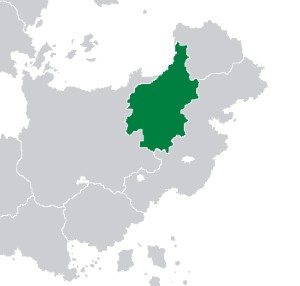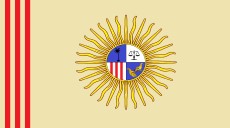Jossia
The Azzurri Republic of Jossia La Repubblica Azzurra di Jossia | |
|---|---|
|
Flag | |
| Motto: Unity in Strength | |
| Anthem: In Defense of Our Freedom | |
 Location of The Azzurri Republic of Jossia (in light green) within Asteria Inferior (light grey). | |
| Largest city | Tellaro |
| Official languages | Vespasian |
| Ethnic groups (2019) |
|
| Demonym(s) | Jossian |
| Government | Federal Presidential Constitutional Republic |
• President | Irene Fornaciari |
• Vice President | Luca Tesconi |
• President of the Senate of the Republic | Gianni Ragavianno |
• President of the Chamber of Represenatives | Rapayet Pushaina |
| Legislature | National Congress |
| Senate of the Republic | |
| Chamber of Represenatives | |
| Independence from Etruria, 1808 | |
• Colonization | 1532 |
• Independence | 1808 |
• Azzurri Revolution | 1998-2001 |
• Azzurri Republic | 2002 |
| Population | |
• 2020 estimate | 33,192,786 |
• 2018 census | 32,498,160 |
• Density | 515,683.84/km2 (1,335,615.0/sq mi) |
| GDP (nominal) | estimate |
• Per capita | J$23,462 |
| Currency | Jossian Dollaro (JSD) |
| Time zone | UTC+15 (Western Lumine Time) |
| Date format | mm-dd-yyyy CE |
| Driving side | left |
| Internet TLD | .jos |
Jossia, officially The Azzuri Republic of Jossia (Vespasian; La Repubblica Azzuri di Jossia), though more commonly known as The Republic of Jossia (Vespasian; La Repubblica di Jossia), is a sovereign country located in northeastern Asteria Inferior on Kylaris. Jossia is bordered by Satucin to her west, and Gapolania to the east, and has a maritime border with both nations on the East Arucian Sea. The population of the country is largely concentrated in the urban centers of the coast, with it being more rural and sparsely populated further inland. Jossia is a federal constitutional republic with the capital in Tellaro, the country's largest city and main economic hub.
The country is composed of four main geographic regions Northwest Jossia is composed of a flat and fertile subtropical coastal plain. Further inland, both to the east and southwest, elevation increases steadily and then plateaus, forming a region of high plains, or the Altipiano in Vespasian. Southwest of the Altipiano lies the Colline Rossa, a swathe of rugged hills. Beyond the Colline Rossa and Altipiano, the Sierra Bianca mountain range cuts through Jossia diagonally towards the north east, forming the southeastern savannas of the Grande Pianura.
Etymology
The word Jossia is from Vespasian origin and means “holy lands.” According to historians, the name Jossia is attributed to Etrurian explorer Giacomo Borghese when his fleet sailed into the East Arucian Sea in 1526. The name Jossia was used in its official capacity after the beginning of the colonization process in 1532.
History
The Azzurri Republic of Jossia is the former colony of Etruria, having declared independence from the Etrurian First Republic in 1808.
Pre-Colonial Era
Before the arrival of Eucleans in the Asterias, modern day Jossia was inhabited by two major indigenous cultures: The Chanota, west of the Sierra Bianca mountains, in the hill country and the fertile coastal plain, and the notYaruro, savanna dwellers east of the mountains. Within Chanota culture, the Picunche people of the coastal plain were sedentary, and relied mainly on agriculture and fishing, cultivating maize, cassava, legumes, and other foodstuffs. The hill-dwelling Itaheuche were relied mainly on a mix of agriculture, llama husbandry, hunting and gathering, and were semi-nomadic. Both the Picunche and the Itaheuche produced silverwork, and elaborate textiles, and both were known to build earthworks and defensive fortifications to defend against rival communities. The Dabu hunted and gathered on the savannas and waterways beyond the mountains, and had no fixed settlements.
Colonial Era
Exalted Republic of Poveglia Povelian explorer Giacomo Borghese when his fleet sailed into the East Arucian Sea in 1526 and returned before the War of the Seas. Colinizaiton 1532 First Ertuian Republic - independence for colonial possessions? 1785-1800 - Revolution declared independence from the Etrurian First Republic in 1808.
The First Republic
The Second Republic
Great War
Solarian War
Late 20th Century
Jossia has dealt with short-lived governmental changes in the late 20th century leaving a wake of state-sponsored terrorism and corruption that stained the soul of the nation. After the market crash of 1980, Jossia suffered from a financial fallout that included corporate bankruptcies, leading the nation into a recession. Within a year, the nation struggled with mass unemployment, food shortages, and public riots throughout the nation. General Benito Maltoni came to power in 1984 after aligning himself with Admiral Alfredo Candia in a military coup that overthrew the struggling President Carlos Bresciani in his last year of office. To pull the nation out of crisis, Maltoni simplified the tax code, cut taxes, curbed foreign spending, and created a massive public works program in an effort to modernize the economy. There was also a state takeover of strategic industries, notably oil and steel, to improve the nation’s strategic resources. In three years the economy grew more than 25 percent and unemployment fell 74 percent, but the program more than doubled the national debt.
Government intervention in industry was very uneven as Maltoni’s public works programs were only directed to expand its manufacturing sector, and quickly lacked direction elsewhere. A poor harvest during Maltoni’s second term in 1991 led to a grain crisis where government intervention provided subsidies for domestic growers but also cut spending and importation, creating widespread inefficiencies and food shortages throughout the nation’s urban areas. The move enraged many and pushed Maltoni to look outside for support. In 1992 President Maltoni signed the Treaty of Gatôn and joined seven other nations to create the Asteria Inferior Common Market, or ASTCOM.
As Maltoni’s government continued its reign for a third term, the people of Jossia started to rise up in protest of the growing inequality in the state The Azzurri, or Blue Coats, were the chief organizers of protests and led riots in all major cities throughout Jossia. Fearing his life, Maltoni ruled with an iron fist, consolidating his power and slaughtering dissidents in the name of progress. His downfall came in 1999, when Maltoni ordered his troops to fire on a Mapuche village after Jossia’s intelligence agencies suspected an attempt to blow up the Presidential Compound in Calabrimo. The wholesale murder of the village triggered an outrage from the nation. The Azzurri led the people in a revolution to bring back a democratic government for good. Led by future President Antonio Quarentata, the Azzurri Revolution from 1998-2001 against Maltoni’s government was a bloody, but successful, war for freedom. After the revolution, the support of the Azzurri was so strong across the nation, the state was renamed in their honor.
The Third Republic
Now, a progressive state in its 18th year of pink tide, Jossia’s left-wing government continues to right the wrongs of its past, prosecuting human rights violators and paving the way for industrial growth, creating fiscal and trade surpluses to pay down debt.
Geography
Climate
Environment
Government
Constitution
Executive
Legislative
Judicial
Elections
Foreign Affairs
Political Parties
Administrative Divisions
Military and Law Enforcement
Trying to erase its corruptive, militant past, Jossia restructured its military and limited its power at the start of the 21st century. In 2003, Jossia enacted the Defense Law, which set to modernize the armed forces only for the use against foreign aggression, cease conscription laws enacted in the 1980s to lessen the size of each branch,limit the powers of each Branch’s leaders, and centralize operations under the authority of the President’s Joint Forces General Staff. The Jossia Armed Forces now consist of three professional volunteer branches, Army, Navy, and Air Force.The main focus of the current military is to continue to modernize and provide humanitarian aid along with protection of the region's waterways. The total active personnel in the Armed Forces is 169,000 and its current budget has decreased to 1.6% GDP. [list] [*]Army: 102,000 personnel [*]Navy: 49,000 personnel [*]Air Force: 18,000 personnel[/b] [/list]
Economy
Jossia is a developed nation with a mixed market economy supported by primary industries of oil and metals. The nation possesses a developed industrial sector that provides numerous goods for the Asturian markets, like food processing, textiles and apparel, and tertiary industries in transportation and electronics. A growing number of the nation’s energy supply comes from renewable resources (12%) but Jossia’s oil industry maintains a strong grasp on energy production and consumption. The nation is considered a middle-income country and ranks well in economic freedom, but struggles in income equality. Jossia is moving towards becoming a socially progessive country, with heritage protection programs for its indigenous population and Equal Marriage Laws, but is still struggling to push the needle further left. Urban centers make up 82% of the population. Jossia is a middle power, a regional power, and a member of various international organizations, including the Community of Nations, International Council for Democracy, International Trade Organization, the Organization of Asterian Nations, the Asteria Inferior Common Market, and the League of Oil Producing States
Energy
Jossia is leader in energy production in Asteria Inferior. They have the fourth largest oil reserves and the second largest coal reserves after Nuvania. It is the second largest producer of coal and crude oil within Asteria Inferior, which contributes approximately J$X to the economy annually..
Jossia produces X barrels of oil per day, with an annual production value of J$X. The nation produces $JX worth of petroleum, and J$X worth of fuel oil annually. Most of these products are produced in refineres located in the Basilicala region of Jossia, in particular in the Flumicio Refinery with a production capacity of 390,000 barrels per day. Jossia has three oil refineries located around the state, with the Asterian Oil Corporation (AOC) and the JosOil Company being the largest operating in the state.
Jossia produces X million tons of coal worth J$ annually, with coal production accounting for X% of total fuel production and X% of fuel exports. A majority of the coal is consumed for domestic electritcity geeneration, with exports to Asterian countries acccounting for the remainder of production. Ghiottone and Andrisani are two of the largest companies that operate coal mines in Jossia.
Nuclear energy first made its appearance in Jossia in the 1960s when the nation established a government organization to explore and develop nuclear power. Today, there is only one nuclear reactor in Jossia, the 418 MW SessaUno, a pressurized heavy water reactor that entered commercial service in 1978. After the coup of 1984, Admiral Maltoni announced that Jossia had the capability to produce weapons grade uranium, but the nation has yet to build the facilities to do so or provided evidence they could. Since the Azzurri Republic, Jossia has pledged to use nuclear power solely for peaceful purposes. The nation is a proponent for non-proliferation and is highly committed to global nuclear security.
Manufacturing
Mining
Services
Agriculture
Infrastructure
Science and Technology
Nuclear energy first made its appearance in Jossia in the 1960s when the nation established a government organization to explore and develop nuclear power. Today, there is only one nuclear reactor in Jossia, the 418 MW SessaUno, a pressurized heavy water reactor that entered commercial service in 1978. After the coup of 1984, Admiral Maltoni announced having the capability of producing weapons grade uranium, but the nation has yet to build the facilities to do so or provided evidence they could. Since the Azzurri Republic, Jossia has pledged to use nuclear power solely for peaceful purposes. The nation is a proponent for non-proliferation and is highly committed to global nuclear security.

